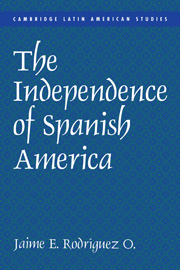4 - Civil War in America
Published online by Cambridge University Press: 05 October 2013
Summary
The dramatic French victories of 1809, which drove the Junta Central to Cádiz, convinced many Americans and some peninsulares in the New World that Spain might not survive as an independent nation. Their fears appeared to be justified when the Junta dissolved itself at the end of January 1810 and appointed a Council of Regency. Americans questioned the legality of that action but, in addition, they believed that the Regency was probably a puppet of the Junta of Cádiz or, perhaps, of Napoleon Bonaparte himself. Fear of domination by the French emperor, widely known in the Spanish world as el tirano, strengthened the desire of many in America to govern at home. In 1810 movements for autonomy reemerged in Venezuela, Rio de la Plata, Chile, Quito, New Granada, and New Spain, all seeking to establish local juntas in the name of the imprisoned King Fernando VII.
Historians generally have assumed that these movements invoked the name of Fernando VII to mask their real goal: achieving independence. But there is strong evidence to the contrary. Not only did the leaders of the American juntas insist that they were acting in the name of the sovereign, they even invited Fernando to govern.
The American juntas based their actions on the same juridical principle that their Peninsular counterparts invoked: In the absence of the king, sovereignty reverted to the people. Although that principle justified the formation of local governments in the name of Fernando VII, it did not support separation from the Monarchy.
- Type
- Chapter
- Information
- The Independence of Spanish America , pp. 107 - 168Publisher: Cambridge University PressPrint publication year: 1998

